Content
Preparing weigela for winter is an important component of caring for ornamental shrubs. A profusely flowering bush of a heat-loving plant grown in the middle zone is a source of special pride for any gardener. To achieve the decorative qualities of weigela, care should be taken to choose the right variety and provide the plant with the most comfortable conditions. Among plant varieties, Weigela middendorf, Weigela flowering and Weigela early are distinguished by relative frost resistance. Many flower growers in the Moscow region plant weigela of these varieties over the winter even without shelter. The remaining varieties require careful insulation for the winter. The features of protecting weigela from winter cold depend on the variety and climate of the area.
Preparing weigela for winter in autumn
If the shrub grows in a sunny place, protected from cold winds, in fertile soil that is not prone to waterlogging and receives good care during the growing season and flowering, then it tolerates the cold season well. Experienced gardeners begin preparing weigela for winter long before the end of the summer season. Moderate but regular watering, periodic loosening, and proper fertilization help increase the plant's endurance.
The goal of caring for weigela in the fall is to ensure that the plant is prepared for winter. The general algorithm for autumn work is as follows:
- bush trimming;
- feeding;
- preparation of materials and tools for work and insulation of plantings;
- removing from the site all fallen leaves and other plant debris that may contain pathogens and pests;
- pre-winter watering;
- mulching of tree trunk circles;
- plant shelter.
Pre-winter watering and mulching
Watering the plantings in preparation for winter prevents soil freezing. It is produced at the end of September in such a way that each bush receives 3-4 buckets of water. If the autumn is dry, it is enough to irrigate the plantings once a week until the onset of frost or snow. If by this time the weather has become rainy, there is no need for additional watering, since excess moisture is detrimental to the roots of this plant.
Mulching is another important stage in preparing shrubs for frost. It is produced regardless of whether the plant is covered for the winter or not. To prevent fungal diseases, the soil should be treated with a fungicide before mulching. In the last days of September, the soil around the tree trunk is loosened, and the trunk is covered with a layer of fertile soil up to 30 cm high.Then pour a layer of mulch up to 10 cm thick. For this purpose, organic materials are used: foliage, peat, humus, spruce branches.
How to prune weigela in autumn
Weigela tolerates pruning well and responds to it with the formation of new shoots, abundant flowering and general improvement. Shearing done in the fall allows you to strengthen the crown, which has a beneficial effect on the ability of the shrub to safely overwinter. 1
Timing for autumn pruning of weigela
Weigela of any variety blooms on last year's shoots, so pruning should be done immediately after the bush blooms. Some varieties can be pruned as early as the end of June, while others will have to wait until September. If weigela blooms 2 times, then pruning should be done in the fall, after the second flowering.
Rules and schemes for pruning weigela in the fall for beginners
The following video illustrates how to prune ornamental shrubs that bloom on last year's shoots, including weigela, in the fall.
The technology for pruning weigela in summer or early autumn involves the following work:
- trunk circles and lower branches are treated with fungicide to protect the bush from fungal diseases;
- dried and damaged shoots are cut a few millimeters above the second living bud;
- remove weak branches;
- cut off faded inflorescences;
- To rejuvenate the plant, about a third of the old shoots are cut off. A rejuvenating haircut is carried out once every 3–4 years;
- to thin out the crown, cut off the branches growing inside the bush;
- shoots that are too prominent are pruned to make the weigela more decorative.
To prevent plants from becoming infected, garden cutting tools are disinfected, for example, calcined over a fire or wiped with alcohol. All sections with a thickness of 15 mm or more are treated with oil paint or garden varnish.
How to feed weigela in the fall
After pruning, the bush should be fed with potash or phosphorus-potassium fertilizers, which strengthen the branches and help the plant better adapt to winter temperatures. Ash is often used instead of mineral fertilizers. Additionally, you can add compost or a solution of cow manure at the rate of 1 part raw material to 10 parts water.
If weigela has not been pruned, autumn feeding is carried out in the first half of September.
How to cover weigela for the winter
The quality of its flowering next season depends on how correctly the weigela is covered for the winter.
You need to cover the weigela after the first cold weather sets in. Light frosts at the beginning of winter will not damage the bush, but will only harden it. In addition, you should wait until the growing season has completely stopped.
Is it necessary to cover weigela for the winter?
Weigela's winter hardiness improves with age: adult plants practically do not suffer even from long frosts. Prolonged frosts can only freeze the shoots, which will lead to less abundant flowering in the next season, but will not radically damage the plant.
It is necessary to cover the bush in the following cases:
- young - up to 5 years of age - plants and especially newly planted or transplanted bushes;
- weigela heat-loving varieties when grown in harsh winter conditions;
- shrubs whose crown can be damaged by snow.
How to properly cover weigela for the winter
Covering weigela for the winter should be done on a dry, frosty day so that there is no moisture remaining under the covering material, which can provoke fungal diseases.
Usually one of two methods is used to construct a shelter for wintering shrubs:
- Frame. This method is suitable for small bushes up to 50 cm in height. A structure is constructed from plastic, metal or wooden arches so that the bush fits completely under it. Supports are also suitable, from which you can make something like a hut. The structure is covered with insulation on top, its edges are fixed to the soil. The resulting shelter resembles a greenhouse. If the winter promises to be particularly harsh, additional straw or hay is placed on top of it. It is not recommended to use film as a covering material so that during thaws moisture does not accumulate under it and the plant does not suffer from rot. It is best to use a breathable material, such as agrotex or spunbond.
- Bending down shoots. Tree trunk circles are insulated with grass, brushwood or spruce branches. The branches are collected, wrapped in insulating material (usually burlap) and carefully bent. All that remains is to secure the bush in this position with hooks, add additional mulch and cover it with roofing material.
In regions with snowy winters, the best covering material is snow, but you still shouldn’t count on heavy snowfalls and it’s better to insulate the shrubs.
In winter, it is necessary to ensure that fragile branches do not break under the layer of accumulated snow.
However, in winter, not only frosts are dangerous for weigela, but also the bright winter sun, which can harm the unprotected bark.The plant can get sunburn from sudden temperature changes. If the bushes are not insulated with covering material, the plants should be shaded from particularly bright sunlight.
How does weigela overwinter?
The departure of weigela for the winter is characterized by the cessation of sap flow and immersion in a state of rest. Depending on the weigela variety and the winter hardiness zone in which it grows, plants overwinter with or without insulation. Heat-loving varieties cultivated in the south practically do not require additional insulation measures. Frost-resistant varieties also do not provide shelter in moderately frosty winters. Heat-loving varieties in the northern regions must be covered.
When to open weigela after winter
Caring for weigela in the spring is designed to restore the plant after winter, stimulate the growing season and prepare it for abundant flowering. Already in March, before the winter shelter is removed, the bush is fed with mineral complexes.
The cover from weigela, as well as from other ornamental heat-loving shrubs, is removed, adhering to the following rules:
- You can start the procedure when the danger of frost has passed. In the middle zone, as a rule, the plant is opened at the beginning of the second ten days of April;
- you need to start by ventilating the shelter without removing it completely;
- holes should be made in the covering material for gradual access of air;
- The mulch that has compacted over the winter needs to be loosened a little to ensure access of fresh air to the roots;
- It is best to remove the cover on a cloudy day so that the bush can adapt to the spring sun and not get burned;
- It is recommended to shade the bushes within 1 – 2 weeks after removing the insulation.
After the cover is removed from the weigela, sanitary pruning of the bush is done to remove all frozen and damaged branches.
Some gardeners, after overwintering weigela in open ground, complain that the plant has dried out. If this happens, moderate but regular watering will most likely help. Even when the plant looks completely lifeless, thanks to periodic irrigation, by the summer it will be able to grow again from the remaining buds, and in some cases will even bloom in the same season.
Conclusion
Preparing weigela for winter requires some effort, but still is not very difficult even for a novice amateur gardener. If all the preparatory work is done correctly and on time, this heat-loving shrub will delight the eye with long, lush flowering even in cold regions. Even if for some reason the weigela freezes, the shrub will quickly recover thanks to its amazing ability to regenerate.

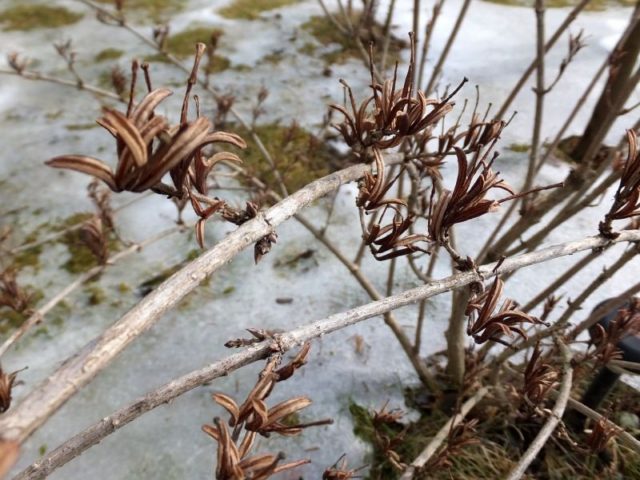

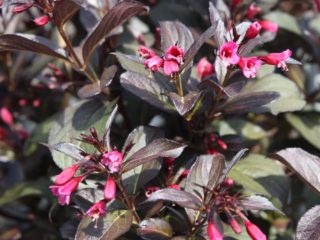
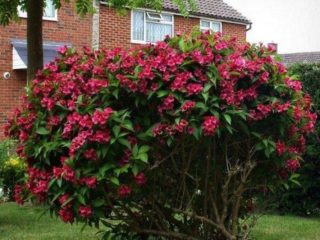
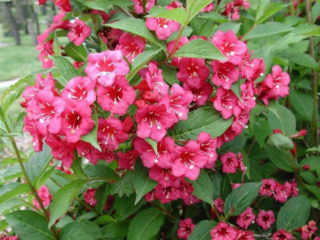
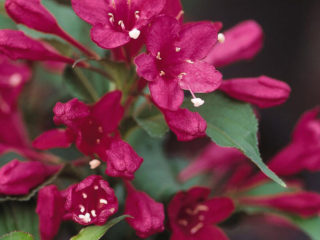

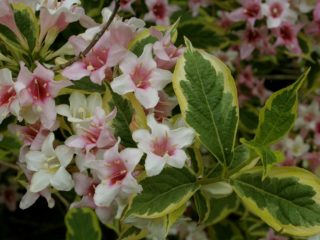
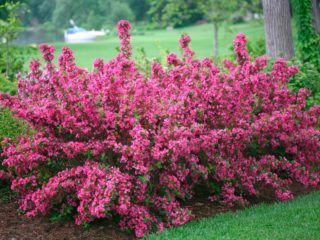
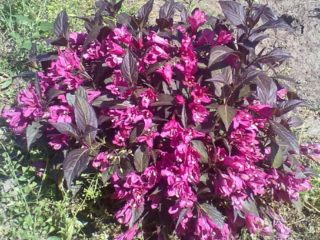
How to ensure wintering of weigela shoots 1.5 years old. Where to keep it, at home in pots or on the veranda, what to feed, how to water it, when can you plant it in open ground? Thank you.
Good afternoon.
If weigela seedlings are 1.5 years old, then they can already be transplanted into open ground. The main thing is to have time to replant the shrub in a month or a month and a half before the onset of cold weather. The algorithm for planting weigela in the fall is practically no different from planting in the spring. But it is worth noting that when transplanting in the fall, a large percentage of young seedlings die, since they do not tolerate frost well. More details about planting weigela in open ground can be found in the article
https://mygarden-en.desigusxpro.com/sad-i-ogorod/dekorativnye-kustarniki/kustarnik-veygela-posadka-i-uhod-vesnoy-letom-foto-video.html
Rules for storing seedlings:
• Store seedlings at a temperature of +5 +10° C.
• It is best to store rooted shoots in pots or in the cellar.
• It is necessary to water as the top layer of soil in the pot dries. Check the seedling about once every week and a half, and moisturize if necessary. It is important that the soil in the container is constantly slightly moist. But overwatering should not be allowed, as the roots will rot. You can use hydrogel balls or moss. They will retain moisture and gradually “give it” to the plant.
• If you have appropriate conditions on your veranda, you can leave them on the veranda for the winter. It is also allowed to store seedlings on the balcony, loggia, cellar, or basement. It is important that there is a minimum amount of light in the room, and the air temperature is not higher than permissible.
• When storing weigela seedlings in a pot until spring, fertilizing is not required. The main thing is to add the necessary fertilizers to the soil when planting in the spring.